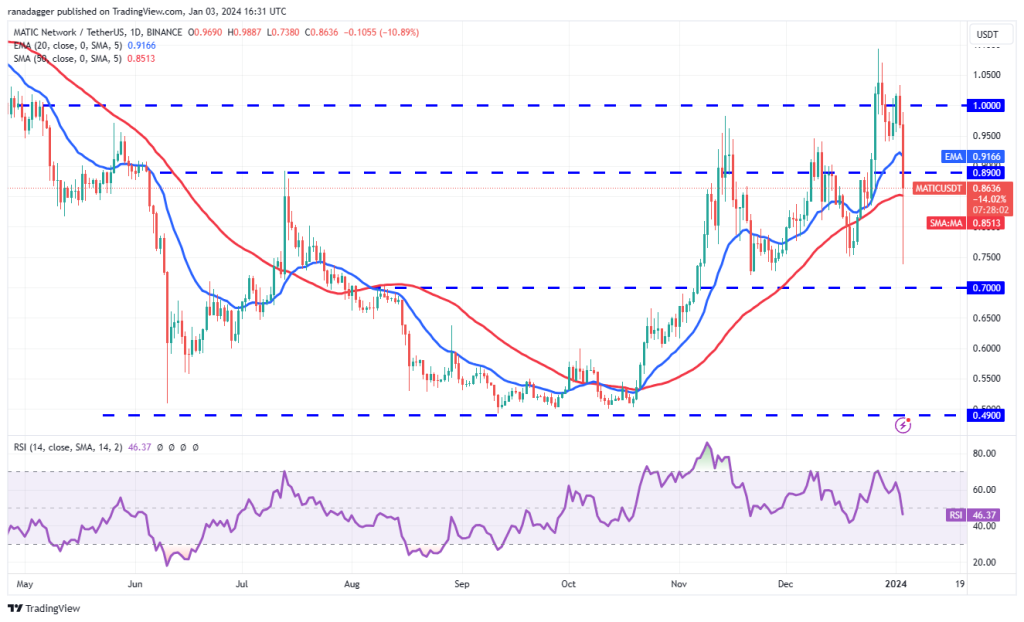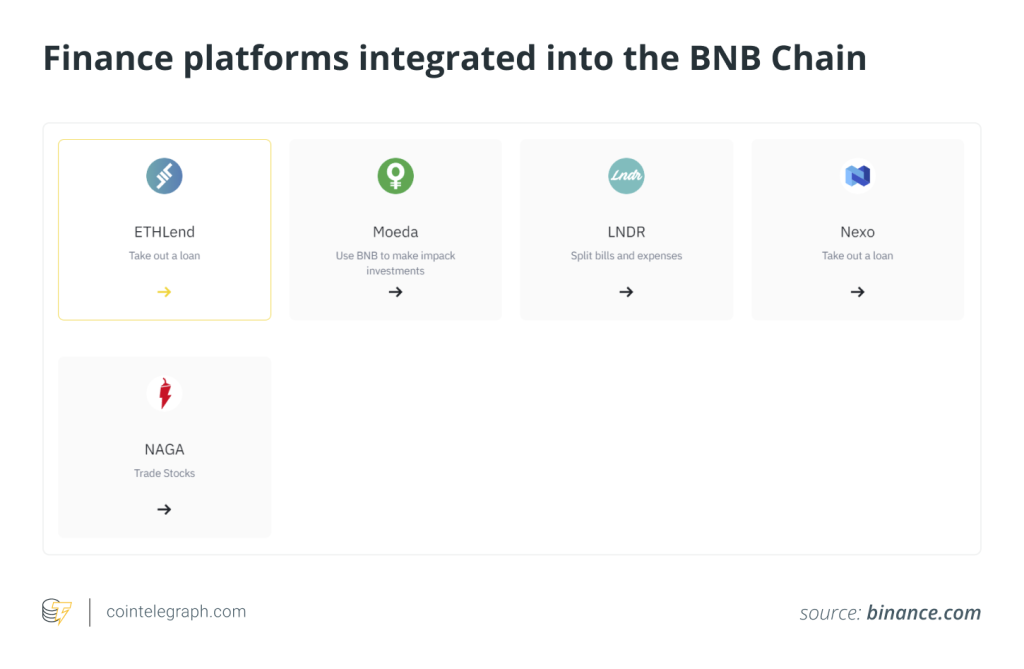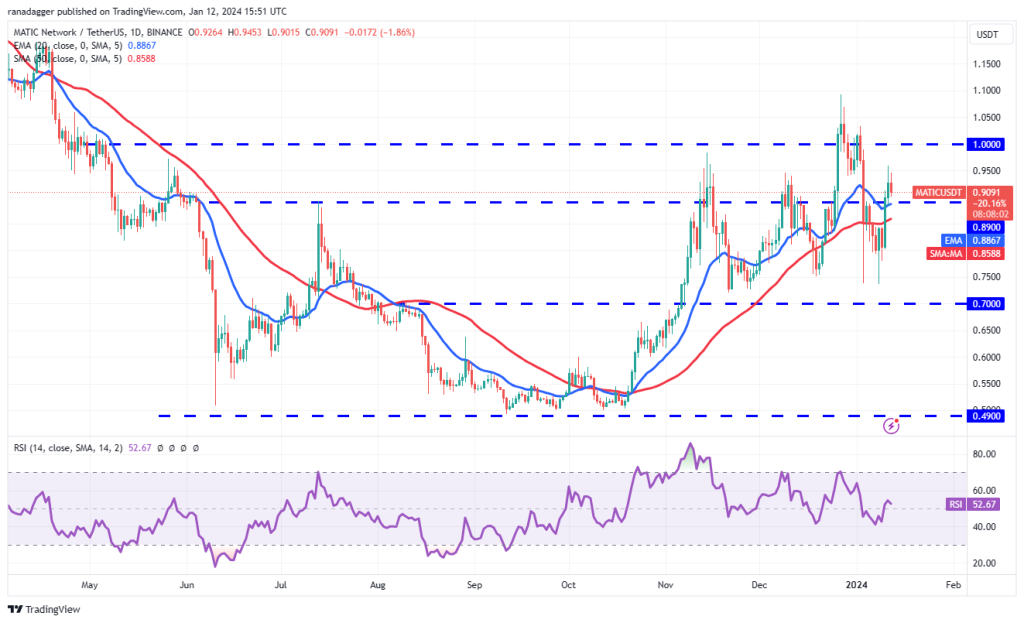Price analysis 1/3: BTC, ETH, BNB, SOL, XRP, ADA, AVAX, DOGE, DOT, MATIC

Bitcoin’s sharp fall on Jan. 3 suggests that market participants are nervous ahead of the SEC’s long-awaited decision on the spot Bitcoin ETF applications.

Bitcoin (BTC) led the cryptocurrency markets lower on Jan. 3, indicating the market’s nervousness about the fate of the spot Bitcoin exchange-traded funds (ETFs) applications. One of the reasons being talked about is the Bitcoin ETF denial report by the crypto financial services platform Matrixport.
However, it is prudent to note that the report fails to provide hard evidence on why the ETFs will be rejected. In contrast, Bloomberg ETF analyst James Seyffart maintained a 90% approval odds of the ETFs by Jan. 10.

Although the fall cools down the bullish sentiment in the short term, it does not alter the prevailing trend. Market observers will keep a close eye on the regulator, and any positive news on the approvals of the Bitcoin ETFs could cause a sharp reversal to the upside.
What important support levels may arrest the decline in Bitcoin and altcoins? Let’s analyze the charts of the top 10 cryptocurrencies to find out.
Bitcoin price analysis
Bitcoin broke above the overhead resistance of $44,700 on Jan. 2, but the breakout proved to be a bull trap as the price plunged on Jan. 3.

Buyers purchased the dip to the 50-day simple moving average ($40,938), indicating that the bulls are vigorously defending the $40,000 level. The flattening 20-day exponential moving average ($42,855) and the relative strength index (RSI) near the midpoint suggest a range-bound action in the near term. The boundaries of the range could be $40,000 and $45,879.
If the price plummets below the $40,000 support, it will suggest that the bulls have given up in the short term. That may sink the BTC/USDT pair to the next major support at $37,980.
Buyers will be back in command after they thrust the price above $45,879. The pair may then surge to $50,000.
Ether price analysis
The bulls tried to kick Ether (ETH) above the $2,445 resistance on Jan. 2, but the long wick on the candlestick shows selling at higher levels.

The price turned down sharply on Jan. 3 and plunged below the moving averages. A minor positive is that the buyers purchased the dip at $2,100 and are trying to hold the price above $2,200.
The price action of the past few days suggests that the ETH/USDT pair may oscillate between $2,100 and $2,400 for a while longer. The bears will have to sink the price below $2,100 to start a deeper correction to $1,900. On the upside, a rise above $2,445 could open the doors for a rally to $3,000.
BNB price analysis
BNB (BNB) attempted a rally from the 38.2% Fibonacci retracement level of $309, but the bears sold aggressively and pulled the price near the 61.8% retracement level of $290.

The long wick and the long tail on the Jan. 3 candlestick show indecision among the bulls and the bears. The 20-day EMA ($290) remains the essential level to watch out for because a break below it may result in a retest of the neckline.
A slight advantage to the bulls is that the 20-day EMA is sloping up, and the RSI remains in positive territory. If buyers keep the price above the 20-day EMA, the BNB/USDT pair could climb to the overhead resistance of $338.
Solana price analysis
Solana’s (SOL) recovery stalled at $117 on Jan. 2, indicating that traders are selling on rallies toward the overhead resistance of $126.

The selling accelerated on Jan. 3, and the bears yanked the price below the 20-day EMA ($96). If the price sustains below the 20-day EMA, the SOL/USDT pair could fall to the 50-day SMA ($76).
On the contrary, if the price maintains above the 20-day EMA, it will indicate solid demand at lower levels. That may start a rally back toward the $117 to $126 resistance zone, where the bears are expected to pose a strong challenge.
XRP price analysis
XRP (XRP) has been forming a descending triangle pattern, which will complete on a close below $0.57.

The bears dragged the price below $0.57 on Jan. 3, but the bulls aggressively bought the dip, as seen from the long tail on the candlestick. If the price rises back above $0.57, the bulls will try to start a recovery toward the downtrend line.
Contrarily, if the price sustains below $0.57, it will signal the completion of the bearish setup. The XRP/USDT pair could then nosedive to $0.46 and eventually to the pivotal support at $0.41.
Cardano price analysis
Buyers failed to sustain the breakout above the symmetrical triangle pattern in Cardano (ADA) on Jan. 2, indicating a lack of demand at higher levels.

The selling picked up on Jan. 3, and the bears pulled the price below the triangle’s support line. The ADA/USDT pair dropped to the 50-day SMA ($0.50), but the long tail on the candlestick shows solid buying at lower levels.
Any recovery attempt is likely to face selling at the 20-day EMA ($0.59). If the price turns down from this level, it will indicate a change in sentiment from buying on dips to selling on rallies. That may put the 50-day SMA at the risk of a breakdown. If this level gives way, the pair may fall to $0.46.
On the contrary, a rally above $0.64 will improve the prospects of a break above the overhead resistance at $0.68.
Avalanche price analysis
Avalanche’s (AVAX) recovery fizzled out at $43.44 on Jan. 2, indicating that the bears are selling on every minor rise.

The selling accelerated on Jan. 3, and the AVAX/USDT pair tumbled below the $38 support. This move completed a bearish head-and-shoulders pattern, signaling the start of a corrective phase.
There is strong support at $31, but if this support is taken out, the pair may drop to the pattern target of $26. This negative view will be invalidated in the near term if the price climbs back above $44.
Related: Crypto investment products saw $2.2B total inflows in 2023 — CoinShares
Dogecoin price analysis
Dogecoin’s (DOGE) support at the 50-day SMA ($0.09) snapped on Jan. 3, indicating that the consolidation resolved in favor of the bears.

The bulls are trying to start a relief rally, but their attempts are likely to face strong selling at the 20-day EMA ($0.09). If the price turns down from the 20-day EMA, the DOGE/USDT pair could descend to $0.07. This level is likely to attract buyers, but if the bears prevail, the pair may fall to $0.06.
The bulls will have to push and maintain the price above the $0.10 to $0.11 resistance zone to signal the start of the next leg of the uptrend to $0.16.
Polkadot price analysis
Polkadot (DOT) rebounded off the strong support at $7.90 on Jan. 1, but the higher levels could not be maintained.

The price reversed direction on Jan. 3 and broke below the formidable support at $7.90. That intensified selling, and the DOT/USDT pair collapsed to $6.50. However, the bulls aggressively bought this dip, as seen from the long tail on the day’s candlestick.
The 20-day EMA ($7.94) is likely to act as a strong resistance on the way up, but if this level is scaled, the pair could jump to $8.80. Contrarily, if the price remains below the 20-day EMA, the possibility of a retest of $6.50 increases.
Polygon price analysis
Polygon (MATIC) rose above the overhead resistance at $1 on Jan. 1, but the bulls could not build upon the breakout.

The price turned down and broke below $1 on Jan. 2. The MATIC/USDT pair witnessed a massive fall on Jan. 3, plunging to $0.74. This sharp decline suggests that the pair remains range-bound between $0.75 and $1 for a while longer.
Buyers will have to drive the price back above the 20-day EMA ($0.91) to reduce the selling pressure. That could result in a rally to $1. On the other hand, if the price stays below the 50-day SMA ($0.85), the pair could slide to $0.70.






… [Trackback]
[…] Read More here on that Topic: x.superex.com/news/ethereum/1768/ […]
… [Trackback]
[…] Find More on that Topic: x.superex.com/news/ethereum/1768/ […]
… [Trackback]
[…] Info on that Topic: x.superex.com/news/ethereum/1768/ […]
… [Trackback]
[…] Read More here on that Topic: x.superex.com/news/ethereum/1768/ […]
… [Trackback]
[…] Here you will find 71874 more Information to that Topic: x.superex.com/news/ethereum/1768/ […]
… [Trackback]
[…] Read More Information here to that Topic: x.superex.com/news/ethereum/1768/ […]
… [Trackback]
[…] Find More Info here on that Topic: x.superex.com/news/ethereum/1768/ […]
… [Trackback]
[…] Find More here to that Topic: x.superex.com/news/ethereum/1768/ […]
… [Trackback]
[…] Find More here on that Topic: x.superex.com/news/ethereum/1768/ […]
… [Trackback]
[…] Information on that Topic: x.superex.com/news/ethereum/1768/ […]
… [Trackback]
[…] Info on that Topic: x.superex.com/news/ethereum/1768/ […]
… [Trackback]
[…] Info to that Topic: x.superex.com/news/ethereum/1768/ […]
… [Trackback]
[…] Read More on that Topic: x.superex.com/news/ethereum/1768/ […]
… [Trackback]
[…] Here you can find 96216 more Information to that Topic: x.superex.com/news/ethereum/1768/ […]
… [Trackback]
[…] Read More on that Topic: x.superex.com/news/ethereum/1768/ […]
… [Trackback]
[…] Read More Info here to that Topic: x.superex.com/news/ethereum/1768/ […]
… [Trackback]
[…] Info to that Topic: x.superex.com/news/ethereum/1768/ […]
… [Trackback]
[…] Read More to that Topic: x.superex.com/news/ethereum/1768/ […]
… [Trackback]
[…] There you will find 20777 more Info on that Topic: x.superex.com/news/ethereum/1768/ […]
… [Trackback]
[…] Read More to that Topic: x.superex.com/news/ethereum/1768/ […]